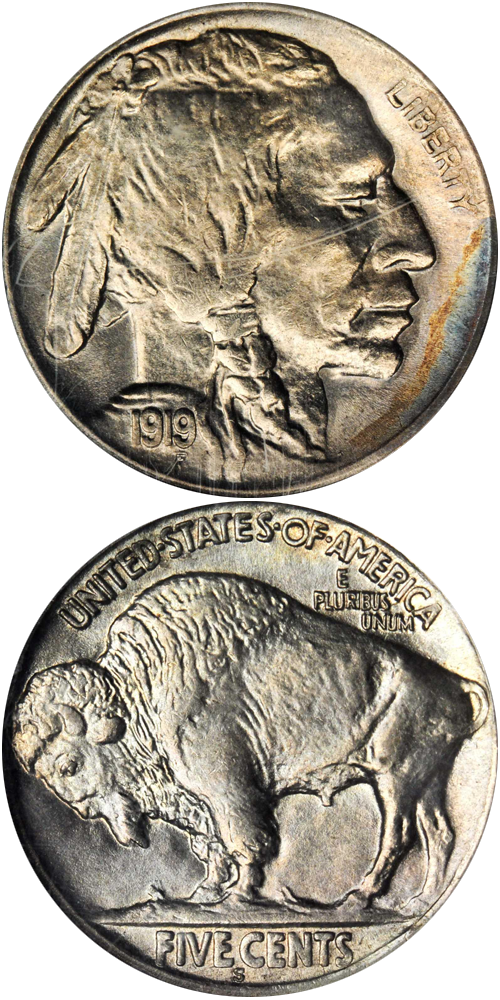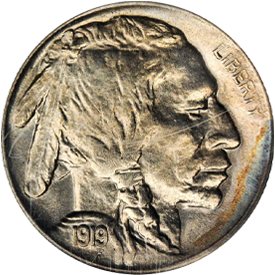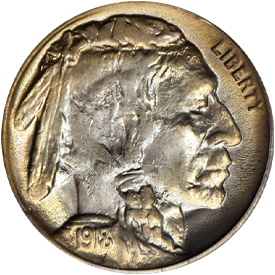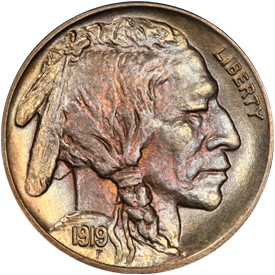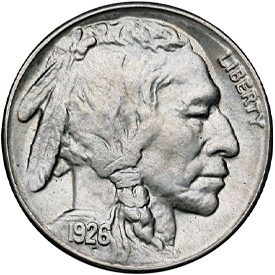Designed by: James E. Fraser
Issue Dates: 1913-1938
Composition: 75% copper, 25% nickel
Diameter: 21.2 mm
Weight: 5.00 grams (77.16 grains)
Edge: Plain
Business Strike Mintage: 1,174,464,771
Like the Liberty or “V” nickel that preceded it, the very first issue of James Earl Frazer’s new Indian or “Buffalo” nickel in 1913 was quickly changed. The denomination “Five Cents” at the bottom on the reverse was raised well above the fields and found to be vulnerable to wear. After several years of circulation, it was thought that this denominational information would be lost, and so a new design in which the denomination was recessed was quickly introduced later that same year. Today, collectors refer to the earlier design as the Buffalo on the “mound” or “raised ground” (Type I) and the later modification as the “plain” or “recessed ground” (Type II).
Due to the hardness of the copper-nickel alloy, many issues of the Buffalo nickel are weakly struck, lacking fine detail on both the Indian and particularly the buffalo on the reverse. In particular, branch mint issues of the late 1910s and 1920s suffer the most from this.
Also like the Liberty nickel, the Buffalo nickel circulated during an era in which five cents had real purchasing power, and examples in low grade could be found in circulation up through the mid-1960s.
Unfortunately, the date was also raised to a high point on the design, but apparently mint officials did not view the loss of a date as particularly serious and this design anomaly was never corrected. As the coins wore, the date disappeared, and as a consequence, a great many Buffalo nickels circulating after the 1950s became “dateless” examples.
Further Reading
In 1913 a new nickel design appeared, the Indian or Buffalo style. Although reference books sometimes call these “Indian head nickels,” nearly all numismatists as well as citizens in general prefer the "Buffalo nickel" term. Perhaps the “Indian” designation is special and is reserved for Indian cents. The nomenclature is further confused by the fact that the creature on the reverse of this particular design is not a buffalo at all but, properly speaking, is a bison. Presumably zoologists know the difference, but most numismatists could care less!
The obverse bears a realistic portrait of an Indian modeled by sculptor James E. Fraser, who used three different Indians to create a composite. The bison on the reverse is a likeness of Black Diamond, who resided for many years in a New York zoo.
Buffalo nickels are of two main varieties, usually referred to as Type I and Type II. Both are necessary to complete a type set.
Buffalo nickels were made from 1913 through 1938 inclusive. In contrast to the Shield and Liberty styles of an earlier era, Buffalo nickels are more like a medal than a coin. There is very little "field" or flat area on either the obverse or the reverse. The coins are almost sculpted in appearance.
A number of interesting scarcities and varieties occur throughout the series. A variety of 1916 occurs with a sharply-doubled date. 1918/7-D is the only overdate in the series and is scarce in all grades, with Uncirculated examples being major rarities.
The high relief of the Buffalo design combined with the hardness of nickel metal made striking a problem. As a result, well struck pieces are the exception rather than rule – particularly among Denver and San Francisco mint issues from 1914 through 1931. Examples are nearly always lightly impressed in certain portions. The most obvious illustration is provided by the 1926-D, a coin which nearly always is indistinct. A piece freshly ejected from the coining press had no more detail than if it had been in circulation for 20 years! However, a few sharply struck 1926-0 nickels exist and are great rarities.
The collector assembling a set of Buffalo nickels soon learns what reasonable expectations are regarding sharpness of details. The building of a completely sharply struck set of nickels from 1913 to 1938 may not be a theoretical impossibility, but considering the life span and patience of the average collector, it is a practical impossibility. I have never seen it done!
In Uncirculated condition and the various gradations thereof, most Denver and San Francisco issues of the 'teens and 'twenties are quite rare, and catalogue values reflect this. A number of clever forgeries have been made by a rather complicated process: by drilling a hole in the edge of a Philadelphia Mint coin, creating a recess below where the S or D mintmark location would be on a branch mint coin, and then pressing or embossing such an S or D by applying pressure from within the coin. The hole on the edge is later sealed, rendering detection difficult.
As is the case with any rare coin, the best protection for authenticity is to buy only certified coins from one of the major services or from an established dealer who guarantees his merchandise. Fabrications are not bargains at any price. Another interesting sham has been conducted from time to time by nickel-plating worn specimens of Buffalo nickels, thus giving them a bright appearance. However, the surfaces are not quite correct and the edges differ on such pieces. A few years ago an "Uncirculated" 1918/7-D nickel advertised at a bargain price proved to be a Very Fine example which had been plated!
The final years of the Buffalo nickel provided two interesting varieties. The 1937-D "three legged" issue has the foreleg of the buffalo missing. This was not caused by an error in design but was due to detail lost when the reverse die was ground down to make it useful for coinage after it had been damaged by "clashing" with the obverse die when both dies came together without a planchet in between them.
The 1938-D/S "over-mintmark" nickel is particularly fascinating. Discovered shortly after 1960, the knowledge of this piece created a sensation among numismatists. Never before had anyone even fantasized that a coin would show two different mintmarks, one over the other. Collectors took out their magnifying glasses, and in the years since then several similar issues have come to light in various series.
What evidently happened is this: Dies for use in the branch mints, Denver and San Francisco, are all prepared at the Philadelphia facility. Those intended for use in San Francisco have "S" mintmarks punched into the die, and those for use in Denver have ''D" letters added. In 1938 the Buffalo design was discontinued. However, coinage was still going on early in the year at the Denver mint, but no examples were made at San Francisco or Philadelphia. Apparently early in 1938 the people preparing dies knew that no further coinage of the Buffalo design would occur in San Francisco. On hand were two Buffalo nickel reverse dies with San Francisco mintmarks. What should be done with them? There were two possibilities: The dies could be discarded (which would result in slight waste) or they could be saved for use by heavily punching a D mintmark over the S. The latter situation is what occurred, and thus the 1938-D/S nickel (which occurs in two minutely different varieties, indicating that at least two reverse dies were prepared in this manner) was created.
Why wasn't the 1938-D/S, an over-mintmark which is glaringly obvious even with a low power glass, discovered earlier? This is a question that was asked many times during the early 1960s when the variety first came to light. Perhaps the most obvious answer is that 1938-D Buffalo nickels were and still are rather common, and no one gave any attention to studying them. As is the case of the famous Purloined Letter story, sometimes the most obvious place provides the most interesting possibilities!
Buffalo nickels of the 1930s are fairly plentiful in all grades. Quantities of Uncirculated pieces were saved of issues after 1934, and occasional groups or rolls of such issues as 1930-S, 1931-S, 1934, and 1934-D are seen, as are quantities of most other issues of the 1930s.
For the collector interested in assembling a set of date and mintmark varieties, a condition expectation of Extremely Fine to AU for issues from 1913 through 1929 (although 1913 Type I is readily available in Uncirculated grade) is reasonable, with the balance of the set from 1930 onward in Uncirculated preservation. Budget permitting, trying for a complete Uncirculated set is a real challenge, but, as always, it is important to be realistic about expectations for sharpness among Denver and San Francisco coins.
Following the discontinuation of the Buffalo nickel in 1938, specimens remained in circulation for many years. Even as recently as the 1950s it was possible to fill many spaces in an album simply by looking through pocket change. Today they have all long disappeared.
